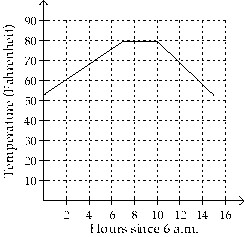Use the graph to solve the problem.In one city, the temperature in Fahrenheit on a typical summer day can be approximated by the following function:
 Here, t represents the number of hours since
Here, t represents the number of hours since  The graph of this function is shown below. At what time does it start to get cooler?
The graph of this function is shown below. At what time does it start to get cooler?
A. At 3 p.m.
B. At 1 p.m.
C. At 10 a.m.
D. At 4 p.m.
Answer: D
You might also like to view...
Determine the limit by sketching an appropriate graph. f(x), where f(x) =
f(x), where f(x) = 

A. -13 B. -3 C. -4 D. 8
Answer the question appropriately.Where does the periodic function f(x) = 5esin(x/2) take on its extreme values?
A. x = ±k?/5 where k is an even integer B. x is an odd integer C. x = ±k? where k is an even integer D. x = ±k? where k is an odd integer
If you changed the following decimal into a fraction and reduced it to lowest terms, what would be its denominator?
?

A. 90 B. 9 C. 999 D. 9999 E. 99
For points 

src="https://sciemce.com/media/3/ppg__cognero__Section_1.2_The_Rectangular_Coordinate_System__media__cb09832f-5ffc-4bd3-af11-e10a5b998974.PNG" style="font-size: 14.6667px; font-family: 'times new roman'; vertical-align: middle;" /> always negative? What will be an ideal response?